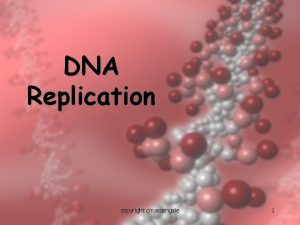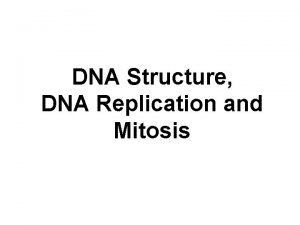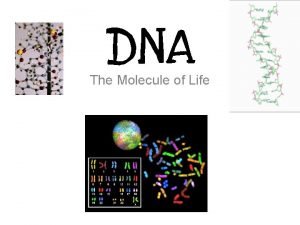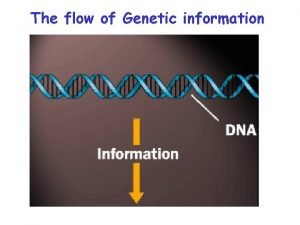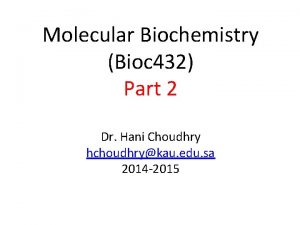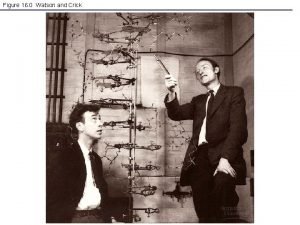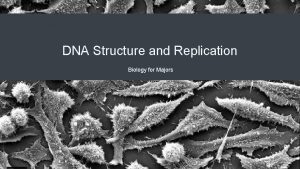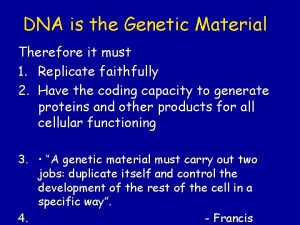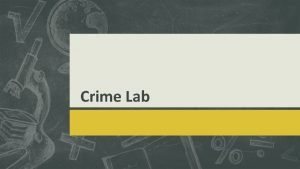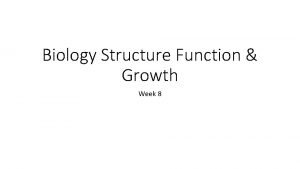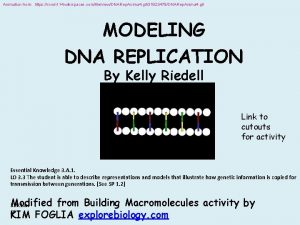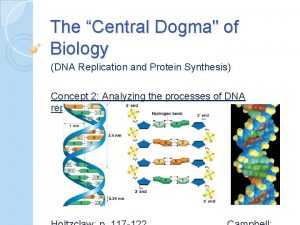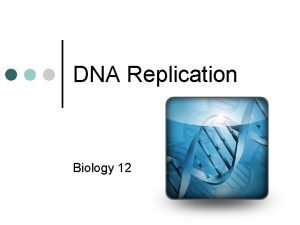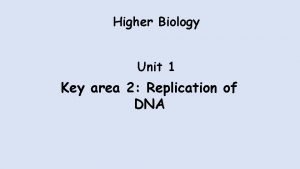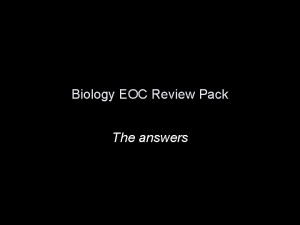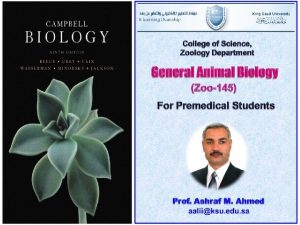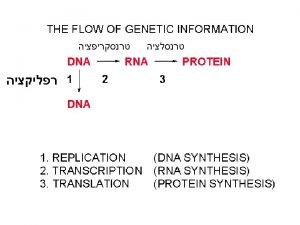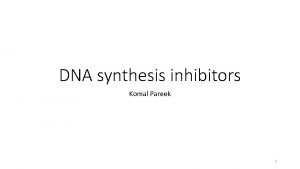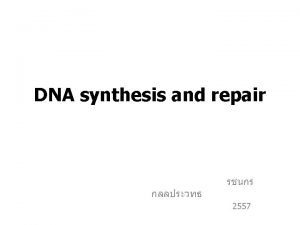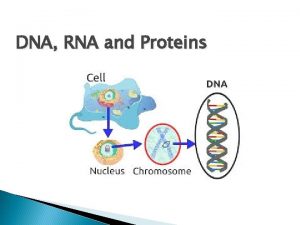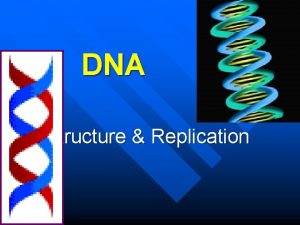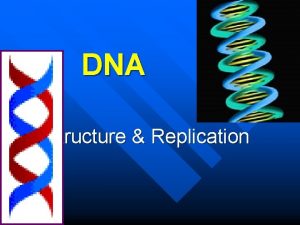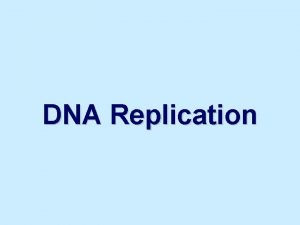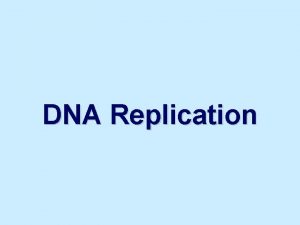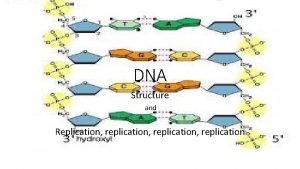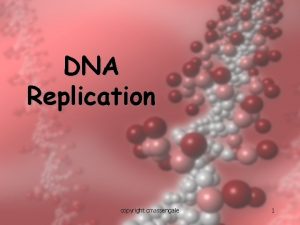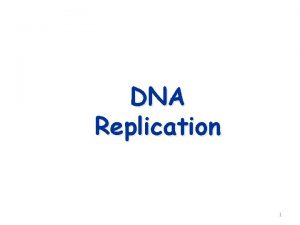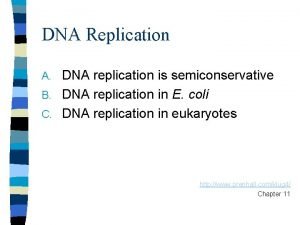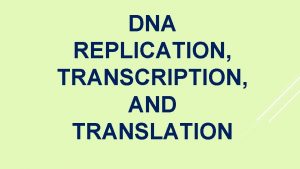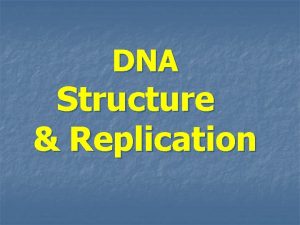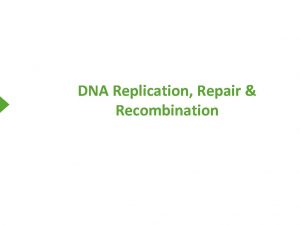DNA Structure Replication DNA Facts n A single





























- Slides: 29

DNA Structure & Replication

DNA Facts n. A single strand of human DNA = about 1 meter long (uncoiled). The total DNA in each cell = about 2 m. n The nucleus of a typical cell has a diameter of 0. 00034 mm = 0. 000013 in n A single strand of DNA contains about 3 billion base pairs. n If the DNA sequence of a person was compiled in books, it would take the equivalent of 200 telephone books, each 1000 pages.

Function of DNA n Stores & transmits genetic info from one organism to next generation n Instructs cells on work to do

DNA in other organelles? Why?

DNA Structure n Deoxyribonucleic Acid n Building blocks nucleotides – 5 -Carbon Sugar (deoxyribose) –Phosphate Group –Nitrogen Base

4 nitrogen bases (A) & Guanine (G) purines n Cytosine (C) & Thymine (T) pyrimidines n Adenine

DNA Strand n Nucleotides bond together polymer n Sugar & Phosphate attached by covalent bonds n Nitrogen bases point outward & attach to each other by hydrogen bonds (weaker)

DNA Double Helix Nucleotide Hydrogen bonds Sugar-phosphate backbone Key Adenine (A) Thymine (T) Cytosine (C) Guanine (G)

Erwin Chargaff n Same amount of A&T and C&G – A pairs only w/T – (2 H-bonds) – C pairs only w/G – (3 H-bonds) n Complementary base pairing rule Source of DNA A T G C Streptococcus 29. 8 31. 6 20. 5 18. 0 Yeast 31. 3 32. 9 18. 7 17. 1 Herring 27. 8 27. 5 22. 2 22. 6 Human 30. 9 29. 4 19. 9 19. 8


Twisted Ladder n B/C Sugar & Phosphate groups do not line up exactly

Double Helix Discoveries n Rosalind Franklin – X-ray diffraction showed DNA helix was 2 -3 strands n Watson & Crick – 1953 – exact structure double helix held together by nitrogen bases


Nucleosome Chromosome DNA double helix Coils Supercoils Histones/proteins

More DNA Facts n If DNA were thickness of a clothesline, the length would be 8 km (5 mi) long. n In bacteria, nucleotides are replicated at a rate of about 500 per second; in mammals, about 50 per second. n During DNA replication, only about one error occurs for every one billion nucleotides made.

ENZYMES made of Proteins n 100 s to 1000 s of chemical rxn in human body n Enzymes speed up rxn by millions and even billions of times n Single enzyme molec. acts on about 1000 substrate molecules/second.

IMPORTANCE OF ENZYMES n Enzymes are biological catalysts. – Lower the amount of energy needed for rxn – Not changed by rxn – Not used up by rxn

They lower the amount of energy needed for a reaction. Reaction pathway without enzyme Reactants Reaction pathway with enzyme Activation energy without enzyme Activation energy with enzyme Products

n. Responsible for metabolism: Catabolism: breaking apart molecules (hydrolysis) § Anabolism: building molecules (dehydration synthesis/condensation rxn) §

Most enzymes are named after the substrate they work on (usually ending in “-ase”). n Lipase-lipids n Protease-proteins n Sucrase-sucrose


DNA Replication n Cells copy info for each new cell n Occurs in nucleus n 3 steps

1. Unzip n DNA Helicase unzips (uncoils) part of DNA strand, breaking H-bonds btwn bases

2. Complementary Base Pairing n DNA Polymerase pairs up free nucleotides with complementary bases (forming new H-bonds)

3. Joining nucleotides n Ligase – joins nucleotides (S+P) w/covalent bonds 2 identical DNA strands, each w/1 new strand & 1 old strand n Semi-conservative replication


Checking for Errors n DNA polymerases are also “proofreaders” n Only add nucleotides to growing chain, if previous base is correctly paired n Backtracks to correct mistake n Only about 1 error for every one billion nucleotides made

DNA Replication Animation

Nucleosome Chromosome DNA double helix Coils Supercoils Histones/proteins
 Bioflix activity dna replication lagging strand synthesis
Bioflix activity dna replication lagging strand synthesis Dna replication facts
Dna replication facts Replication fork
Replication fork Dna and genes chapter 11
Dna and genes chapter 11 Dna structure and replication pogil
Dna structure and replication pogil Dna structure and replication packet answer key
Dna structure and replication packet answer key Nature of dna replication
Nature of dna replication Dna replication steps
Dna replication steps 3-5 exonuclease vs 5-3 exonuclease
3-5 exonuclease vs 5-3 exonuclease Okazaki fragments
Okazaki fragments 3 models of dna replication
3 models of dna replication Major enzymes in dna replication
Major enzymes in dna replication Accgtat
Accgtat Dna jeopardy
Dna jeopardy 3 models of dna replication
3 models of dna replication Dna replication vs pcr
Dna replication vs pcr What is this name
What is this name Kim foglia dna replication
Kim foglia dna replication Bioflix dna replication
Bioflix dna replication Protein synthesis restaurant analogy
Protein synthesis restaurant analogy Replication fork
Replication fork Dna replication transcription and translation
Dna replication transcription and translation Higher biology dna replication
Higher biology dna replication Why is dna replication considered semiconservative
Why is dna replication considered semiconservative Dna replication pearson
Dna replication pearson Direction of helicase
Direction of helicase Dna replication in bacteria occurs
Dna replication in bacteria occurs Dna replication
Dna replication Dna replication eukaryotes
Dna replication eukaryotes Dna replication comic strip
Dna replication comic strip

